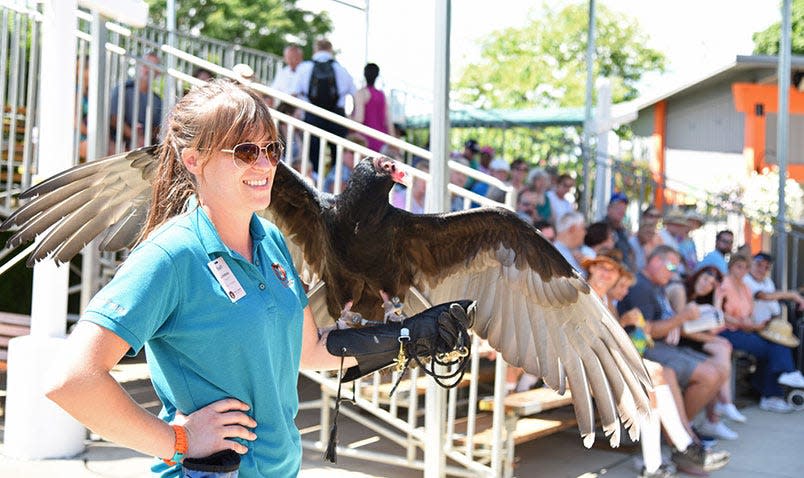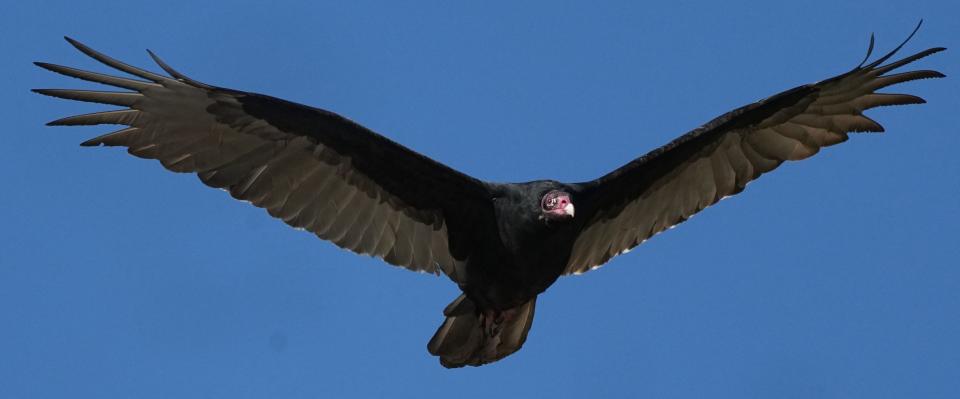Smith: Turkey vultures – 'nature's recyclers' – are a valuable part of Wisconsin's ecosystem

BARABOO – The airspace over Devil's Lake State Park took on the appearance of a cyclone.
This one, though, never touched ground and wasn't likely to be part of any weather report. In fact the spinning, feathered mass was made up of one of the most valuable contributors to Wisconsin's ecosystem.
Hundreds of dark, broad-winged birds effortlessly rode rising air currents in what is known as a "kettle."
If one flapped its wings, I didn't see it. Flying in these conditions was as easy for these birds as it is for us to float down a river in a raft.
I watched for 15 minutes as the birds circled over the park, then drifted north and dropped out of sight. It's possible the dinner bell had rung.
If you're a Wisconsin resident and have ever looked skyward, I'm sure you've seen this species.
It's the turkey vulture.
More: Outdoors calendar
More: Annual survey of deer hunters provides a gauge on Wisconsin wildlife
Turkey vultures are becoming a default species for Wisconsin birdwatchers
My Sept. 18 sighting at Devil's Lake was one of dozens I've had over the last decade of large groups of turkey vultures in Wisconsin.
In fall the birds often gather in large numbers as they stage prior to migration. Devil's Lake is a favorite spot for the species as the area offers ample roosting and feeding opportunities.
But turkey vultures are now commonly seen from Kenosha to Superior. In fact, they are so often sighted these days in Wisconsin they have become the default species for many birding experts.
"If I see a big bird soaring in the sky, I consider it to be a turkey vulture until proven to be something else," said Lindsay Focht, raptor program manager at Schlitz Audubon Nature Center in Bayside. "And I'm always happy either way, because I really appreciate turkey vultures."
Turkey vultures are fairly easy to identify in flight. They are very large, with 6-foot wingspans, and have small heads. They fly with their wings in a v-shape, or dihedral, according to the Peterson Guide to Birds of North America.
They often rock and tilt side-to-side in flight. And if seen at close range, they have an evident bald head (red in adults, gray in juveniles).

Turkey vultures are 'nature's recyclers' that help control disease
You might have also seen a turkey vulture along the side of a road or in a field feeding on a dead animal.
Since turkey vultures primarily eat carrion, the lack of feathers on its head is an evolutionary advantage for the species, according to the Cornell Lab of Ornithology.
It helps the birds stay clean as they feed on dead animals and perform their valuable ecological role.
Though some people may have a bad impression of vultures, Focht calls turkey vultures "nature's recyclers."
"I think it's hard to overemphasize how important turkey vultures are," Focht said. "They can consume and digest virtually any disease known to humans, including anthrax. It's almost like they keep the checks and balances necessary for the ecosystem to thrive."
Turkey vultures are native to Wisconsin but have increased substantially in number and distribution over the last century, according to historical reports.
The species was part of Wisconsin's avifauna since resettlement and even prehistoric times, according to papers published by the Wisconsin Society for Ornithology. It was considered uncommon to rare in the late 1800s and early 1900s, with most birds reported from southwestern counties. A population increase became apparent in some parts of the state by the late 1940s and has continued through the 1990s.
By the mid-1990s the turkey vulture was considered a common breeder in the state.
Bill Volkert, a birding expert and naturalist from Dundee, said he has turkey vultures that nest and gather near his home in the northern Kettle Moraine. He said the species is quite versatile and adaptable, part of its success in recent times.
Volkert said he's known turkey vultures to nest on old cabins, sheds, building ledges and deer hunting blinds as well as natural sites such as cliffs.
Road kill probably contributed to the proliferation of turkey vultures in Wisconsin
Like most others, he's happy to see turkey vultures.
"Well, they are impressive flyers and valuable contributors," Volkert said. "With no disrespect intended, I consider them the garbage crew. They clean up the dead animals on the landscape. It's a food source for them and they provide a service to us."
Volkert said the turkey vulture has very strong stomach acid that allows it to break down decaying flesh and kill pathogens that would "get you and me sick in no time."
One hypothesis to explain the increase in turkey vultures in Wisconsin and other northern states relates to the expansion of the Interstate highway system in the 1950s, the overall increase in vehicle miles driven by humans and consequently more road-killed wildlife.
"The birds have responded to this abundance of deer and raccoons and other animals dead and ready to be eaten," Volkert said. "We should be thankful."
Turkey vultures are extraordinary for many reasons.
Among the most obvious is their ability to smell carrion from as far as 8 miles away, according to the Cornell Lab of Ornithology.
Most birds have very little to no olfactory sense.
The turkey vulture also shines as a flyer. It has been documented to fly as far as 100 miles without a single wingbeat. This efficiency is vital to the survival of a scavenger that doesn’t know when or where its next meal will come.
Biologists once thought that the turkey vulture was a bird of prey and a raptor like hawks, owls and eagles. But in 1994 scientists used DNA tests and found they belonged in the stork family where they are now classified. In fact, Volkert said turkey vultures are not related to the "old world" vultures found in Africa and other continents.
Smart and social, turkey vultures migrate as far as South America
Focht, who helps care for a turkey vulture named Tallulah at Schlitz Audubon, has another couple points to add about the species. They are extremely social and smart, she said.
"They live in social groups in the wild and have a social dynamic unlike many of the other raptors," Focht said. "And our work with Tallulah has shown how smart they are, how they solve problems. I would put turkey vultures on par with Labrador retrievers with the bite of a Rottweiler."
Most of Wisconsin's turkey vultures are now gathering for or starting their fall migration. Some will go to the southern U.S. and others will go as far as northern South America, Volkert said.
Most will return to the Badger State in February or March.
"We're always happy to see them come back," Volkert said. "They really fill a valuable niche and it's great to see them doing well in Wisconsin."
Raptor show set for Nov. 4 in Bayside
Schlitz Audubon Nature Center will hold Xtreme Raptor Day on Nov. 4 at its facility in Bayside. The event is the center's annual festival to celebrate "these powerful hunters of the sky."
Visitors will be able to meet the center's resident raptors, including owls, hawks, falcons, eagles and a turkey vulture, and learn about each species including their habits and habitats.
Stations set around the facility will feature interactive and educational experiences as well as bird-themed crafts and activities. Visitors will also be able to have their photo taken with a raptor.
The event raises funds to support the center's raptor program and the birds in its care. Xtreme Raptor Day will take place indoors and outdoors, rain or shine. The cost is $18 for adults, $15 for you ages 3 to 17 and children under 2 are free. Visit schlitzaudubon.org for tickets or more information.
THANK YOU: Subscribers' support makes this work possible. Help us share the knowledge by buying a gift subscription.
DOWNLOAD THE APP: Get the latest news, sports and more
This article originally appeared on Milwaukee Journal Sentinel: Turkey vultures, now common, are valuable part of Wisconsin ecosystem
